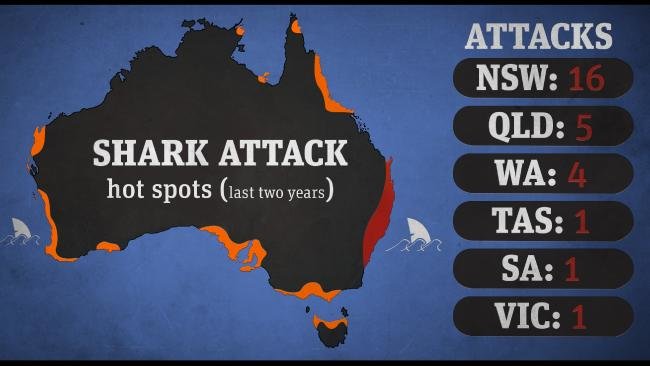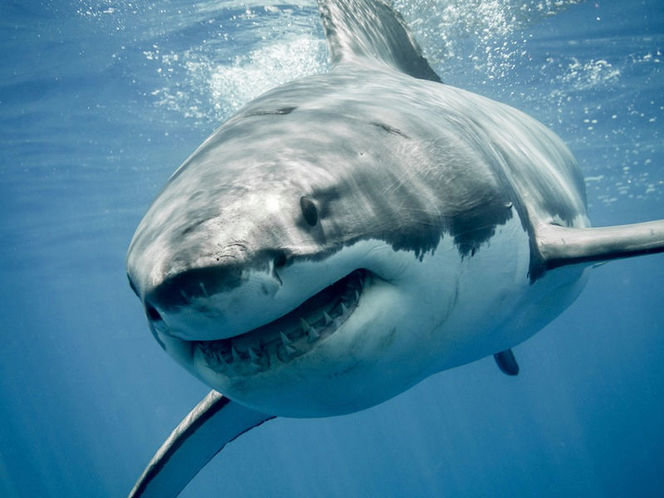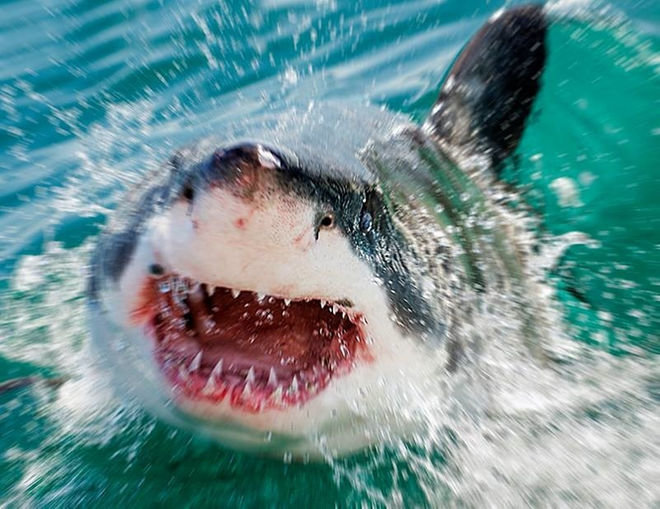It's become the most dangerous stretch of coastline in the country for shark attacks, and the phenomenon has mystified scientists.
"It's impossible to pinpoint causation," said Daryl McPhee, a researcher at Bond University.
He told news.com.au shark attacks have been increasing globally for the past 30 years. "There's no one reason globally, it's a combination of factors," he said, listing things such as weather, environment and proximity to food.
"It's very difficult to work out why there's a concentration on the northern New South Wales coast."

Australia's most dangerous beaches
"We seem them daily, or every second day," said Craig Nowlan, president of the Ballina Surf Club.
"If you're looking for them, you'll find them. Aerial patrols are a great asset, but the reality is a shark can come from out wide straight to the beach and we won't see it."
He's lived in the area for about 30 years, and says he remembers a time when a shark would be sighted only once every six or 12 months.
In Ballina shire alone, there has been four attacks times in the past two years.
— February 2015: Japanese man Tadashi Nakahara was killed near Shelly Beach, suffering severe wounds and major blood loss after being bitten while surfing.
— February 2015: Just one day earlier, local man Jabez Reitman was bitten at the same beach, requiring surgery.
— July 2015: 32-year-old bodyboarder Matt Lee was lucky to survive after being mauled by a suspected four-metre great white at Lighthouse Beach.
— September 2016: Teenager Cooper Allan fought off a huge shark at the same spot, requiring stitches for large gashes in his limbs.
Monday's incident happened at Broken Head, only 20km north. Witness Geoffrey Knapp tweeted a picture with the caption: "One very lucky surfer today".
Lifesavers are constantly on edge, and it can be incredibly traumatising.
"We're trained, but no-one is really prepared for the extreme instances we've had," Mr Nowlan told news.com.au.
"There have been a couple of pretty extreme attacks. It certainly has an impact, and we provide counselling where possible."
Lack of scientific inforrmation
Despite the frequency of shark attacks in New South Wales, Taronga Conservation Society's annual Shark Attack File reveals Western Australia is the deadliest state for 2016, with two fatal incidents in the state's southwest.
Ben Gerring, 29, was mauled by a great white at a popular surf spot near Mandurah in May, passing away from his injuries in hospital. Less than a week later, a five-metre shark killed university lecturer Doreen Collyer, while she was diving off the coast of Perth.
Mrs Collyer's death prompted the state government to redeploy drum lines in the area.
"What is lacking is a lot of scientific information of shark behaviour and the shark population," state Premier Colin Barnett said in June.
"There's a whole lot of natural phenomenon in play and I think we need to understand that better."
Dr McPhee said the number of sharks in the greater Perth area comes down to the availability of food. "There's a systemic correlation in Western Australia, with the concentration of sea lions around the Greater Perth area," he told news.com.au.
Mr Nowlan thinks sharks are in northern New South Wales for the same reason.
"Everyone's got a theory on why there's more now," he admitted. "But there's an increased number of whales in the area, plus there's changes to fishing legislation and the prevalence of marine parks."
"There's no silver bullet"
New South Wales is now following Western Australia's lead for shark defence.
Premier Mike Baird has softened his opposition to shark nets following intense community pressure, and now 100 smart drum lines will be installed along the state's coastline.
"Ultimately we get to the point where we have to prioritise human life over everything," he told the state's parliament on October 12.
"Certainly the sentiment in that local community has shifted. It was against nets, no doubt about it. The recent attacks have started to shift that."
Although both types of drum lines involve baited hooks, smart drum lines don't kill sharks — rather, they allow authorities to tag, remove and relocate them.
"There's no silver bullet, no one-thing-fits-all," said Ballina mayor David Wright.
"Any creatures caught will be tagged and released, and 45 great whites have been tagged so far. We're also promoting the use of individual devices like shark shields."
The animals are now being tracked, and he said most of the tagged sharks have gone away.
"There are a lot of sharks out there, but most of the time they're not annoying anyone."
According to Dr McPhee, tagging is the best hope for researchers.
"Tagging and tracking is the main tool to gain an understanding of their movement," he told news.com.au. "That's the key source of scientific information."
Scientists don't know how many sharks there are, and currently there's no way to tell if the population is increasing or decreasing.
How to tell if you're in the danger zone
Australia has the second-highest incidence of unprovoked attacks in the world, behind the United States, and the rate has increased over the past three decades.
"It's still a very, very rare event," Dr McPhee told news.com.au. "Over the last 30 years there have also been a lot more people in the water, and due to things like social media, they're obviously garnering a lot more attention."
There are also a number of precautions swimmers can take to avoid sharks.
"Obviously, they need to swim between the flags, and swim at patrolled beaches where possible," Mr Nowlan told news.com.au. "If not, be aware of key indicators for sharks. Avoid swimming at dawn or dusk, avoid swimming in dirty water, and observe bird activity. If they're diving into the water, that indicates a bait ball."
Cr Wright said tourists shouldn't avoid northern New South Wales due to sharks.
"Come to Ballina, definitely come to Ballina. We've got the river, the beaches are fantastic. If you want to swim, especially over Christmas, every beach will have lifeguards. We've got 34 kilometres of beaches. Ballina's honestly got so many other things going for it."





Blame it on Belushi and his Land Shark sketch on SNL, it seems the rest of the clan want in on that kind of fun.